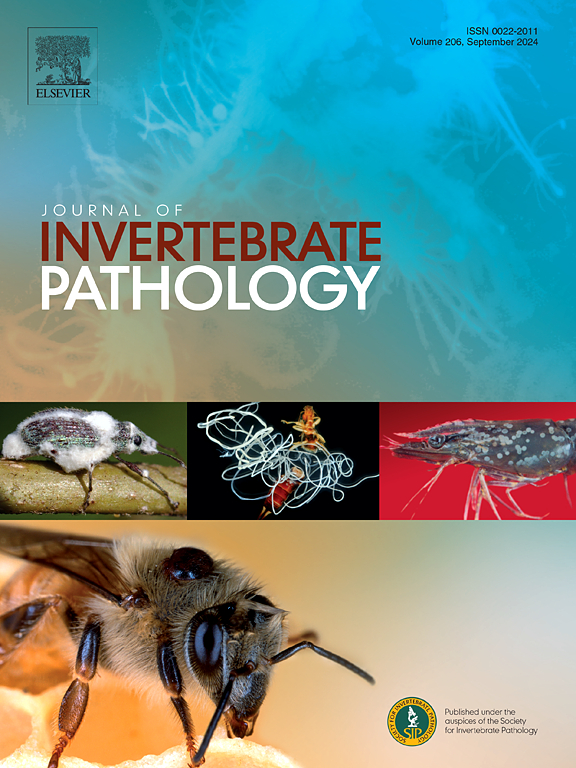肠道菌群诱导宿主中肠免疫反应,并参与对炉玉米螟Cry1Ac原蛋白的防御
IF 2.4
3区 生物学
Q1 ZOOLOGY
引用次数: 0
摘要
昆虫的肠道菌群在宿主的发育、消化、免疫和病原体抗性中起着至关重要的作用。苏云金芽孢杆菌(Bacillus thuringiensis, Bt)因其产生杀虫原毒素的能力而被公认。然而,目前对玉米螟的Bt毒素、寄主肠道菌群和肠道免疫之间的相互作用还缺乏系统的研究。我们的研究结果表明,Bt Cry1Ac原蛋白显著诱导中肠免疫反应,引起细菌群落的动态变化,并增加了炉芽孢杆菌中肠和血液中的细菌总负荷。此外,肠道菌群的缺失显著增加了furnacalis幼虫对Cry1Ac原毒素的敏感性。重新引入5种肠道共生菌株OfG3(癌肠杆菌属)、OfG4(四川克卢韦拉氏杆菌属)、OfG5(水痘克雷伯氏菌属)、OfG6(格林蒙克雷伯氏菌属)和OfG7(弗氏柠檬酸杆菌属),显著降低了无氧和正常弗氏弧菌幼虫对Bt Cry1Ac原蛋白的敏感性。我们的研究进一步表明,肠道菌群的缺失导致大多数免疫相关基因的表达显著下调,而五种肠道共生菌菌株(OfG3-OfG7)的引入显著上调了正常furnacalis幼虫中肠中抗菌肽(AMP)基因的表达水平。这些结果表明,肠道菌群在调节寄主中肠免疫和减轻Bt Cry1Ac原毒素的毒性方面发挥着重要作用,为改善Bt抗性管理和开发新的鳞翅目害虫生物防治策略提供了有价值的见解。本文章由计算机程序翻译,如有差异,请以英文原文为准。

Gut microbiota induces host midgut immune response and contributes to defending against Bt Cry1Ac protoxin in Ostrinia furnacalis
Insects’ gut microbiota plays essential roles in the development, digestion, immunity, and pathogen resistance of the host. Bacillus thuringiensis (Bt) is recognized for its ability to generate insecticidal protoxins to kill insect pests. However, systematic studies on the interplay between Bt toxins, host insect gut microbiota, and gut immunity are still lacking for Ostrinia furnacalis. Our findings demonstrate that the Bt Cry1Ac protoxin significantly induces the midgut immune responses, causes a dynamic shift in bacterial communities, and increases the total bacterial load within the midgut and hemocoel of O. furnacalis. In addition, the absence of the gut microbiota significantly increased the susceptibility of O. furnacalis larvae to Cry1Ac protoxin. The reintroduction of five intestinal commensal bacterial strains, OfG3 (Enterobacter cancerogenus), OfG4 (Kluyvera sichuanensis), OfG5 (Klebsiella variicola), OfG6 (Klebsiella grimontii), and OfG7 (Citrobacter freundii), markedly reduced the susceptibility of both axenic and normal O. furnacalis larvae to Bt Cry1Ac protoxin. Our study further demonstrated that the loss of the gut microbiota resulted in a significant down-regulated expression of most immune-related genes, and the introduction of five gut commensal bacteria strains (OfG3-OfG7) significantly up-regulated the expression levels of antimicrobial peptide (AMP) genes in the midgut of normal O. furnacalis larvae. These results suggest a critical role for the gut microbiota in modulating host midgut immunity and mitigating the toxicity of Bt Cry1Ac protoxin in O. furnacalis, offering valuable insights for improving Bt resistance management and developing novel biological control strategies for lepidopteran pests.
求助全文
通过发布文献求助,成功后即可免费获取论文全文。
去求助
来源期刊
CiteScore
6.10
自引率
5.90%
发文量
94
审稿时长
1 months
期刊介绍:
The Journal of Invertebrate Pathology presents original research articles and notes on the induction and pathogenesis of diseases of invertebrates, including the suppression of diseases in beneficial species, and the use of diseases in controlling undesirable species. In addition, the journal publishes the results of physiological, morphological, genetic, immunological and ecological studies as related to the etiologic agents of diseases of invertebrates.
The Journal of Invertebrate Pathology is the adopted journal of the Society for Invertebrate Pathology, and is available to SIP members at a special reduced price.

 求助内容:
求助内容: 应助结果提醒方式:
应助结果提醒方式:


